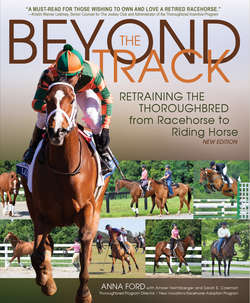Читать книгу Beyond the Track - Anna Morgan Ford - Страница 37
На сайте Литреса книга снята с продажи.
Оглавление3
Common Lameness
and Health Issues
3.1 Recently retired Thoroughbreds can suffer from a number of health and lameness issues, so it is important to perform a general check for soundness before beginning a retraining program.
Thoroughbreds are athletes and the extensive training they undergo at a young age takes both a physical and mental toll. Racing itself puts tremendous physical strain on a horse’s body as he pushes himself to peak performance again and again. Hoof and leg-related lameness are common, as is body soreness resulting from the stress and physical demands experienced on and around the track. It is no surprise then, that following retirement, most of these athletes need some sort of treatment or physical therapy to speed recovery. In many cases, rest proves to be the best medicine, but there are a variety of care regimens that can help transition a horse’s mind and body to get him healthy.
Pre-Purchase Exams
The Adopted OTTB
As I recommended in the last chapter, before making a commitment, you can ask about a horse’s health history, and in most cases you will get an honest and informed answer. However, most adoption programs do not have the finances to fully vet every horse that comes through the barn door—instead, veterinarians are called in to assess and treat major injuries or seek the causes of specific maladies. With this in mind, those adopting an animal with the intent to compete him at a high level may choose to have a pre-purchase exam done before they assume ownership—but do note it is the adopter’s responsibility to have the horse checked if he feels it is necessary. At New Vocations, we encourage adopters to take the horse home and arrange to have their own vet look him over when the time and expense can be spared. In most cases, this is sufficient.
If you plan to pursue a discipline that demands more of your horse than casual pleasure riding—in other words, one that is physically demanding or involves obstacles—it is advisable to have a vet examine your horse before you begin his training program. This can include having his eyes, lungs, and heart checked for irregularities, and X-rays as needed, based off flexion tests (see p. 45).
The OTTB Purchased from the Track or at Auction
If you buy a horse directly from the shed row at the track, there may not be an opportunity for a professional pre-purchase exam. Some trainers will allow an exam, and a track veterinarian may even be on hand to perform one, but more often than not, logistical issues will get in the way. Therefore, when you find a horse you like, it is a good idea to be prepared to assess his soundness yourself—unless you’re looking for a pet or companion animal, you probably won’t want to bring a potentially crippled animal home just because you like his looks (see below for a soundness test). If you like the horse but you aren’t confident in your own abilities to detect problems or unsoundness, bring a knowledgeable friend or your trainer to get a second educated opinion.
Some trainers are fairly honest about injuries (bowed tendons, quarter cracks, and bone chips, to give just a few examples), as they want to see a horse go to the most appropriate home. Other trainers just want to get the horse out of the way quickly, and even if he is clearly unsound, they may assure you, “He will be fine with some turnout.” In these cases, the trainer may know where the horse is sore but may not know the full extent of the injury because he could not pay for X-rays—for example, the horse may have fetlock soreness so the trainer applied a sweat or “injected” it, when in reality there is a bone chip or fracture that would be best treated with surgery. Unfortunately, horse trading is always a “buyer beware” market.
And of course, if you pick up an OTTB at an auction, all bets are off!
Underlying Problems
As you transition your Thoroughbred, keep in mind that many behavioral issues you may automatically attribute to his upbringing at the track could instead be the result of discomfort. Before you reprimand him or lose patience, consider that he may have a physical problem your veterinarian can identify. Understanding that this is a possibility and having an idea of the kinds of pain and unsoundness poor behavior can indicate is an important attribute in an OTTB owner.
On the following pages, I address the following:
1 How to perform a soundness evaluation.
2 Common race-related injuries.
3 Common hoof issues.
4 How to deal with gastric ulcers.
5 Recommended treatments for lameness.
6 Alternative medicines and therapies.
A Simple Soundness Evaluation
When a Thoroughbred arrives at New Vocations, we perform a general soundness exam before we incorporate turnout into his regimen or begin any training. A sound horse is free from injury, illness, or conformation defects that may impede his ability to perform at present or in the future. He moves without hesitation and does not limp or otherwise display pain or discomfort. Note that a horse may have an old injury that no longer affects him and still be deemed sound.
There is a lot that the average horseman can do to evaluate a horse’s soundness, keeping in the back of your mind that you can consult a veterinarian if necessary. Below I’ve provided a description of how to perform a simple examination, either before you bring a new horse home or prior to starting work with him. I recommend you write down your observations so that if there appears to be a problem, you can thoroughly explain your findings to your vet.
